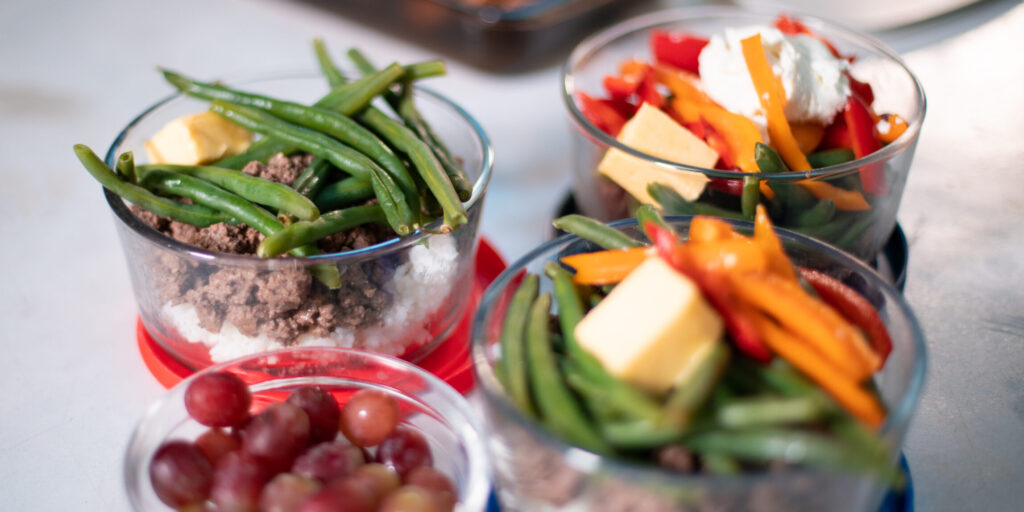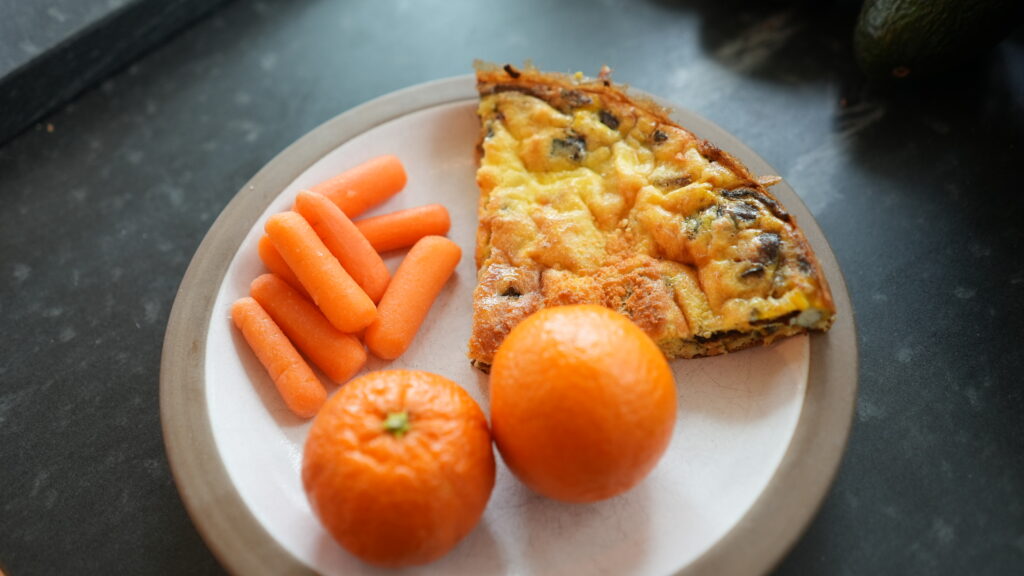3 Nutrition Musts to Stay Lean Year Round
Want to ditch restrictive diets and still look good and move well?
Me too. So I’m following up on the article I wrote on 12+ diets over 12+ years. What I learned from all of them are that sticking to a just a few things is all you need.
When I cover today’s 3 nutrition must-haves, I can maintain my physique year round. And I feel healthy and perform well too.
Don’t miss your free download below for some simple tasty recipes that cover all the bases!

1) Protein - But Make it Lean
Tired of hearing about protein? Maybe. But is everyone eating what they need? Most definitely not. Give your health, body composition, weight management, and performance a helping hand.
0.7 grams per pound of body weight at a minimum
1 gram per pound of body weight on the high end
Who should aim for the upper range?
- People who train a lot with weights
- People who are older and more susceptible to muscle loss due to aging
Anyone recovering from injury
Who can get by on the lower end of the range?
- People who don’t train very much with weights
-
People who have a lot of body fat to lose and are eating with more substantial calorie deficits
Is it safe to eat more? Absolutely - it just won’t necessarily build more muscle.
Why lean protein?
Because you’ll meet your protein requirements without adding unnecessary calories to your daily target.
For example, quinoa, which is a seed/grain that is common in vegan and vegetarian diets, is touted as having high protein. Relative to other grains this is true. However, to get 180 grams of protein per day from quinoa (my body weight is 180 lbs), I would have to eat approximately 45 cups of cooked quinoa a day. That is roughly 10,000 calories of quinoa in order to reach my recommended protein requirements.
On the contrary, if I consumed all 180 grams of my protein from Whey Protein Powder, I would only need 6.5 scoops of my favorite flavor protein powder from Transparent Labs (Peanut Butter) which is only about 800 calories per day.
The source of your protein matters. This is what people are referring to when they say to get your protein mostly from LEAN sources. It means that the food is MOSTLY protein and has minimal calorie contributions from fat and carbohydrates. The difference can be as much as 9,200 calories!
Does that mean you can’t have quinoa or a ribeye steak? No, but I aim to get my protein each day from the following lean sources:
Egg Whites
Non-Fat or Low-Fat Greek Yogurt and Cottage Cheese
Chicken Breast or Chicken Thighs
93-96% Lean Ground Beef, Turkey, or Chicken
Tuna, white fish, or shellfish
Grass Fed Whey Protein Powder - or any other protein powder that delivers about 25-28 grams of protein per 120 calories
I eat fattier protein sources each day too - because fat is still a vital nutrient. I choose a few fattier sources of protein intentionally to get those healthy fats in. I may consume a small amount of full fat dairy, 2 whole eggs, and fatty fish like sardines.
I also still count all my protein from the plant-based foods I eat each day. There is protein in my oatmeal, potatoes, and veggies. These all count towards my total target each day but I try to make sure they account for less than 30-40% of my total protein grams and that I make sure to get the majority of my protein from those lean sources above.
The lower calorie your diet is, the more you will want to LEAN on lean protein
2) Veggies & Fiber
Staying within your target calorie range - or not - will make or break your results with any eating approach. So it makes sense to fill up on low calorie foods that satisfy. I make sure that each and every meal I eat has a veggie on it or a higher fiber food source.
Some diets encourage and allow for highly nutritious foods that are also very calorie dense. When I ate Paleo and consumed massive amounts of nuts every day, I ran into this problem. Nuts have a host of health benefits to them, but when you eat an entire bag of almonds from Trader Joe’s in a day (trust me this isn’t hard), you get 1350 calories added to your daily total. Over consumption of calories negates the health benefits of your nuts.
When we eat, our brain looks for a signal that we are full. This comes mainly from stretch receptors in our stomach and then some downstream secreted hormones and peptides.
Your body needs to recognize a certain volume of food in your stomach to send the feedback that it is time to stop eating. This is the concept of LOW DENSITY HIGH VOLUME foods. Three cups of broccoli vs. 1 handful of almonds get you similar calories. But the broccoli takes up way more space and will fill you up much more quickly.
Including veggies and fiber at every meal has a profound impact over time on how much you consume. Meal by meal the differences might be small, but over the course of weeks and months, this adds up.
There are a number of other great health reasons to include veggies and fiber on the plate at every meal. These include minerals, micronutrients, and gut health benefits, but probably the single biggest reason to do it is that it will help you manage your caloric intake better over time.
3) Eat to Train, Not to Shrink
While diet is extremely important to having a lean physique year-round, what is more important is how much we move and the quality of our training. You can’t outpace a bad diet with more exercise, but without adequate movement and high-quality training, you will never have a body that looks and performs optimally and with a high level of health.
When I eat to optimize my training, I noticed massive long-term benefits. There have times I was eating to get lean, which meant caloric restriction. Over time as I lost body fat and my calories were depleted for extended periods, my workouts started to suffer. I could not bring the same level of intensity to my training and I started to simply check the box on my workouts.
I fell into the trap of eating less and therefore moving less with less intensity. The alternative is to eat a bit more and move a little more, too. And a great place to start this is with the meals that surround your workouts.
I always focus on getting a great meal both before and after my training. These might be the two most important meals of my day.
This is the place to prioritize getting in PROTEIN and CARBOHYDRATES. Carbs are a massive performance booster. If you are like me and have been afraid of carbs currently or in the past, then this is your invitation to include your carbs back at this specific time.
Carbs are NOT TO BE FEARED. Carbs before your workout and after will lead to more strength, more muscle, better recovery, increased training intensity, and increased metabolism day after day.
Pre-Workout Meal: Overnight Oatmeal with Fruit
Post-Workout Meal - Filly Frittata with 1-2 Small Potatoes
(See recipes below)

Honorable Mentions
Eat Big Early, Eat Small Late
I focus on eating more of my calories early in the day and fewer late in the day. You don’t have to be a big breakfast person, but you can be a big lunch person.
Saving all your calories for the end of the day and having a big dinner is problematic for a lot of people. Eating too much too close to bedtime can disrupt sleep. When you have poor sleep you tend to consume more calories the following day.
When you save your calories for the end of the day and you are very hungry late in the day, it is harder to manage cravings and it becomes easier to overeat. I learned this from trying to follow a traditional schedule of intermittent fasting for a long time. I tried to skip breakfast and ultimately fond myself not doing well with larger meals later in the day. The intermittent fasting schedule that I found worked better for me was skipping my last meal of the day instead. This didn’t work well with my lifestyle ultimately so I no longer do it.
NO SINGLE FOOD IS THE ENEMY
Among all the diets I’ve tried, there was always a food that was the enemy. Carbs, fat, processed foods, veggies, sugar, artificial sweeteners, gluten….
I have come to learn that success will come to those who realize sooner than later that there are no single foods that are the ENEMY. There’s no need to demonize food.
When you categorically cut out whole foods groups, you set yourself up for wanting to binge these foods later on. Depriving yourself of something or creating this negative relationship with a particular food does far more harm than good in my experience. And the truth is you can be super healthy and have a great body while eating any of these foods
Fiber & Veggie Favorite Recipes
Download my favorite meals I’ve been eating that cover all my nutrition bases, and make them your own. These recipes are extremely simple - and that’s the point! They’re easy and delicious, and fast to make in a pinch.
Get Recipes